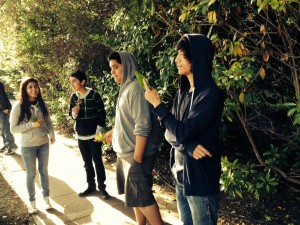Mindfulness in the Classroom

Originally appears in the Summer 2014 issue
I NEVER KNEW THERE WERE so many different flavors to a strawberry,” said a 14-year-old freshman,
when attempting a mindfulness eating exercise.
“I never thought about what it really looks like,” another student said, giggling self-consciously.
A third student took a risk. “This is the first time I’ve ever had a strawberry.”
“And how was it?” I asked.
She shrugged. “Sweet first, then sour, then sweet again.”
“Like life, maybe?” I asked.
The intention of the activity was to mindfully eat a strawberry, an exercise I facilitate on the first day of teaching mindfulness to my students. The word mindfulness has recently found its way into the mainstream lexicon, though it has been in humanity’s lexicon for over 2,400 years. Only recently are people becoming aware of this idea of “paying attention.” Often this is the first time students have ever put
so much attention on eating. Through this simple task, they begin their own personal journey into themselves, and ultimately, grow an increased awareness of their environment.
As a teacher and a former social worker, I have personally noticed the attention span and emotional capacities of my students being compromised. This generation of students exist in a fast-paced, high-expectation culture where they are asked to think nonstop. To put it bluntly, our kids are stressed. Three years ago, this inspired me to begin teaching mindfulness. In the simplest terms, according to Amy Saltzman’s Still Quiet Place curriculum, mindfulness means “paying attention with kindness and curiosity”; an age-appropriate way to define
it to young people. Jon Kabat-Zinn, the first person to begin studying mindfulness from a scientific point of view, defines mindfulness as “paying attention in a particular way; on purpose, in the present moment, and non-judgmentally.” Thanks to Kabat-Zinn and his successors, the mindfulness movement has transcended any negative stereotypes about being hippie-dippy, touchy-feely stuff. On the contrary, the more we teach our students to pay attention to the present moment, the more they begin to heal from the everyday trauma of adolescence -as well as the deeper traumas like poverty, suicidal thoughts, abuse, sleep deprivation, health issues, etc.
I teach both English and Mindfulness in a small charter high school in East Palo Alto, California, a low-income community in the shadow of Silicon Valley. Nearly 30,000 residents are packed into the 2.5 square miles of this community, with an average income per capita of $17,600. The daily challenges of poverty that my students face are evident in the classroom: poor attendance, lack of academic confidence, and very little parental engagement. These conditions are challenging not only for the students, but also for the teachers.
To view the photo-rich magazine version, click here.
If you are not already a subscriber, please subscribe to read the full article
Caren McDonald teaches high school English and Mindfulness in East Palo Alto, California. Before becoming a teacher, she was a social worker and a playwright, having produced plays in Boston, Alaska, New Mexico, Michoacán, and Los Angeles.
Leave a Reply
You must be logged in to post a comment.





